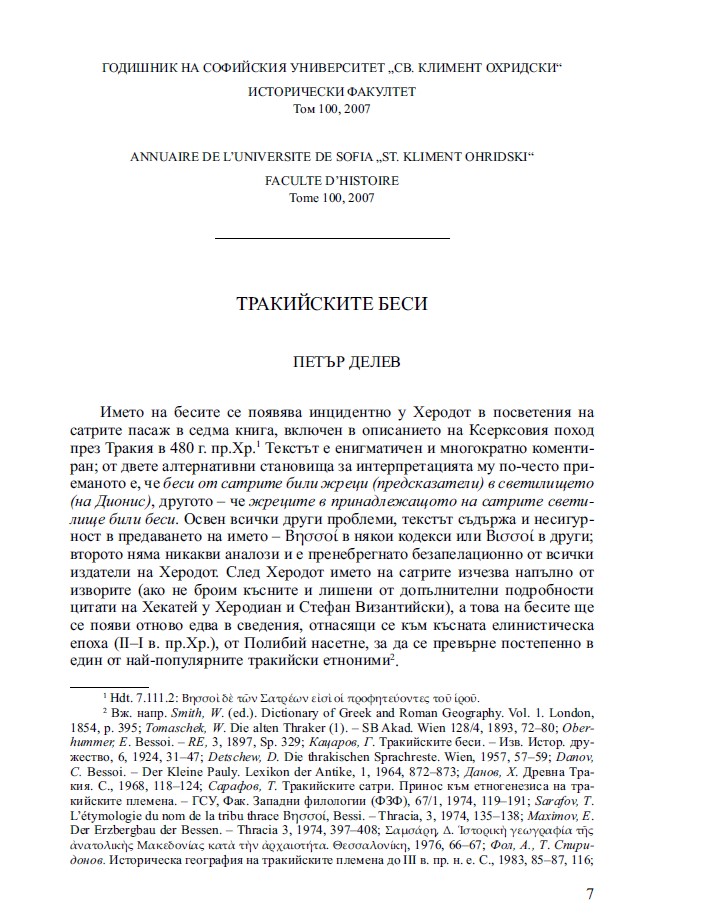Тракийските беси
DOI :
https://doi.org/10.60053/GSU.IF.1.100.6-65Ключови думи :
Тракия, бесиРезюме
В седма книга на Херодот, в пасажа, посветен на сатрите, който сам по себе си е част от описанието на похода на армията на Ксеркс през Тракия през 480 г. пр.н.е., името на бесите се споменава изолирано. Текстът е енигматичен и често е бил обект на обсъждане; съществуват две основни мнения за тълкуването му, като по-често поддържаното е, че бесите от Сатрае са били жреци (или по-скоро ясновидци) в светилището (на Дионис); алтернативното - че жреците в светилището, което е принадлежало на Сатрае, са били беси. Освен всички останали проблеми съществува известна несигурност в предаването на името, като някои от кодексите дават Βησσοί, а други Βισσοί; вторият вариант няма известни аналогии и е категорично отхвърлен от всички редактори на текста. След Херодот името на сатрите изчезва напълно от всички антични текстове (с изключение на паралелните случаи у Херодот и Стефан Византийски, които цитират Хекатей), докато това на бесите в крайна сметка ще се появи отново в редица съобщения, отнасящи се до късната елинистическа епоха (II и I в. пр. Хр.), като се започне от Полибий и след това постепенно се превърне в един от най-популярните тракийски етноними.
Използвани източници
Hdt. 7.111.2: Βησσοὶ δὲ τῶν Σατρέων εἰσὶ οἱ προφητεύοντες τοῦ ἱροῦ.
Cf. e.g. Smith, W. (ed.). Dictionary of Greek and Roman Geography. Vol. 1. London, 1854, p. 395; Tomaschek, W. Die alten Thraker (1). – SB Akad. Wien 128/4, 1893, 72–80; Oberhummer, E. Bessoi. – RE, 3, 1897, Sp. 329; Katsarov, G. Trakiyskite besi. – Izv. Istor. druzhestvo, 6, 1924, 31–47; Detschew, D. Die thrakischen Sprachreste. Wien, 1957, 57–59; Danov, C. Bessoi. – Der Kleine Pauly. Lexikon der Antike, 1, 1964, 872–873; Danov, H. Drevna Trakia. S., 1968, 118–124; Sarafov, T. Trakiyskite satri. Prinos kam etnogenezisa na trakiyskite plemena. – GSU, Fak. Zapadni filologii (FZF), 67/1, 1974, 119–191; Sarafov, T. L’étymologie du nom de la tribu thrace Βησσοί, Bessi. – Thracia, 3, 1974, 135–138; Maximov, E. Der Erzbergbau der Bessen. – Thracia, 3, 1974, 397–408; Σαμσάρη, Δ. Ἱστορικὴ γεωγραφία τῆς ἀνατολικὴς Μακεδονίας κατὰτὴν ἀρχαιοτήτα. Θεσσαλονίκη, 1976, 66–67; Fol, A., Spiridonov, T. Istoricheska geografia na trakiyskite plemena do III v. pr. n. e. S., 1983, 85–87, 116; Spiridonov, T. Istoricheska geografia na trakiyskite plemena do III v. pr. n. e. Atlas. S., 1983, karti 34–40; Kratka entsiklopedia „Trakiyska drevnost“. S., 1993, 38–40 (Orachev); Tacheva, M. Za besite i tehnite plemenni teritorii. – Minalo, 1995, № 1, 9–15; Boteva, D. Etropolskiyat sveti Atanas, Sabaziy i proritsalishteto na besite. – Minalo, 1996, № 2, 18–28; eadem. Problemi na trakiyskata istoria i kultura. S., 2000, 150–159.
Only among those mentioned so far. Herodotus himself recounts in a subsequent passage (8.116) that the king of the Bisaltae and Crestonians withdrew into „the Rhodope“, also refusing to follow the Persians. As Bisaltia is rather far-removed from the Rhodope Mountains, it could eventually be suggested that Herodotus might have made a mistake, substituting the Satrae with the Bisaltae in this second instance (?), but the factual details in both passages decrease the probability of this conjecture. It should be added that in the Bisaltian story the sons of the king disobeyed their father’s orders and nonetheless went with Xerxes, and afterwards when all six returned safe home they were severely punished by their father.
Sarafov, T. Op. cit., r. 137; Sarafov, T. Op. cit., r. 187. A long time ago Wilhelm Tomaschek suggested on the contrary that the Satrae represented a sort of aristocratic élite and the Bessi – the mass of regular subordinate population, admitting also the possibility of ethnic distinction between them (Tomaschek, W. Op. cit., r. 73). aniques, 2, Sofi a, 1970, 141–150; Sarafov, T. Op. cit., 186–187.
Polyaen. strat. 4.4.1: Antipater while leading a war in the lands of the Tetrachoritae ordered that the hay for the horses which was stacked around his tent should be set on fire. When it was ignited the trumpeter gave the signal and the Macedonians gathered around the tent with raised spears. On this sight the tetrachoritae were terrifi ed and abandoned the fortress which they were holding and Antipater took it without a battle.
Pap. Ryland 1.19 = Theopomp. fr. 217 Jacoby.
Frontin. strat. 1.4.13; srv. Hammond, N. G. L., G. T. Griffi th, A History of Macedonia. Vol. 2, 550–336 B. C. Oxford, 1979, p. 580; Delev, P. Filip II i zalezat na „golyamoto“ Odrisko tsarstvo v Trakia. – Vav: Shumenski universitet „Episkop Konstantin Preslavski“. Trudove na katedrite po istoria i bogoslovie, 1, 1997, s. 24.
About the tetrachoritae cf. Oberhummer, E. Op. cit., 329–330; Katsarov, G. Op. cit., p. 31; cf. also Boschnakov, K. Die Thraker „Tetrachoritai“. – Talanta, 22/23, 1990/1991, 7–13, whose hypothesis I do not accept. The name τετραχωρῖται itself could be related to the ancient Greek χωρίον (fort, town, place) in a sense of those of the four forts or to χώρα (land, district, territory) eventually meaning those of the four cantons; the second seems less plausible for the alternative version Τετράκωμοι in Stephanus Byzantinys which certainly derives from κώμη (village, hamlet, settlement).
Hammond, N. G. L., G. T. Griffi th, Op. cit., r. 545.
Plut. Alex. 9.1. Vzh. Hammond, N. G. L., G. T. Griffi th, Op. cit., r. 558.
Polyb. 23.8.3–7; T. Liv. 39.53.12–14. Srv. Const. Porph. de legat. p. 47. About the date cf. Walbank, F. W. Philip V of Macedon. London, 19672, r. 334; Hammond, N. G. L., F. W. Walbank. A History of Macedonia. Vol. 3, 336–167 B. C. Oxford, 1988, r. 468. historical tradition represented by authors like Posidonius, Sallust, Titus Livius and Strabo. What has survived are mainly much later quotations and epitomized accounts which are not only brief but also quite often imprecise and uncertain in the transmission of concrete details.
Cf. e.g. Walbank, F. W. Prelude to Spartacus: The Romans in Southern Thrace, 150–70 B.C. – In: Spartacus. Symposium rebus Spartaci gestis dedicatum 2050 a., Sofi a, 1981, 14–27; Tacheva, M. Istoria na balgarskite zemi v drevnostta prez elinisticheskata i rimskata epoha. S., 19972, 61–83.
Sf. e.g. Strabo 7.5.12: All these tribes are very much addicted to robbery, especially the Bessi who ... are called robbers even by the other brigands; they live in huts and lead a hard life (πάντα μὲν οὖν ταῦτα λῃστρικώτατα ἔθνη, Βέσσοι δέ … ὑπὸ τῶν λῃστῶν λῃσταὶ προσαγορεύονται, καλυβῖταί τινες καὶ λυπρόβιοι); 7 fr. 48: All these tribes are addicted to plunder, particularly the Bessi (ἅπαντα δὲ τὰ ἔθνη λῃστρικὰ ταῦτα, μάλιστα δ’ οἱ Βέσσοι).
On Minucius cf.: Münzer, F. Minucius (No 54). – RE, 15, 1932, 1962–1963; Broughton, T. R. S. The Magistrates of the Roman Republic 1, New York, 1951, 543–544; Σαρικάκις, Θ. Χ. Ῥωμαῖοι ἄρχοντες τῆς ἐπαρχίας Μακεδονίας. Θεσσαλονίκη, 1971, 60–62; Papazoglou, F. Quelques aspects de l’histoire de la province de Macédoine. – Aufstieg und Niedergang der Roemischen Welt 2.7.1, 1979, S. 314.
Degrassi, A. Fasti Capitolini. Roma, 1954, p. 107, fi lls the lacuna with de Scordisteis et Thraecibus; older editions of the Fasti usually suggest de Scordisteis et Triballeis, based on Euthropius. In any case the empty space on the stone seems to suggest two ethnic names. The information gleaned from the inscriptions mentioned below would authorize a possible reconstruction of the text as de Scordisteis et Besseis.
T. Liv. per. 65: M. Minucius proconsul adversus Thracas prospere pugnavit; Frontin. 2.4.3; Amm. Marc. 27.4.10; Eutrop. 4.27; Fest. 9; Flor. 1.39; Iord. Rom. 219.

Файлове за сваляне
Публикуван
Как да цитирате
Брой
Секция
Категории
Лиценз

Публикация с Creative Commons Attribution 4.0 International License.
Годишник на Софийския университет "Св. Климент Охридски" - Исторически факултет (ГСУ-ИФ).







